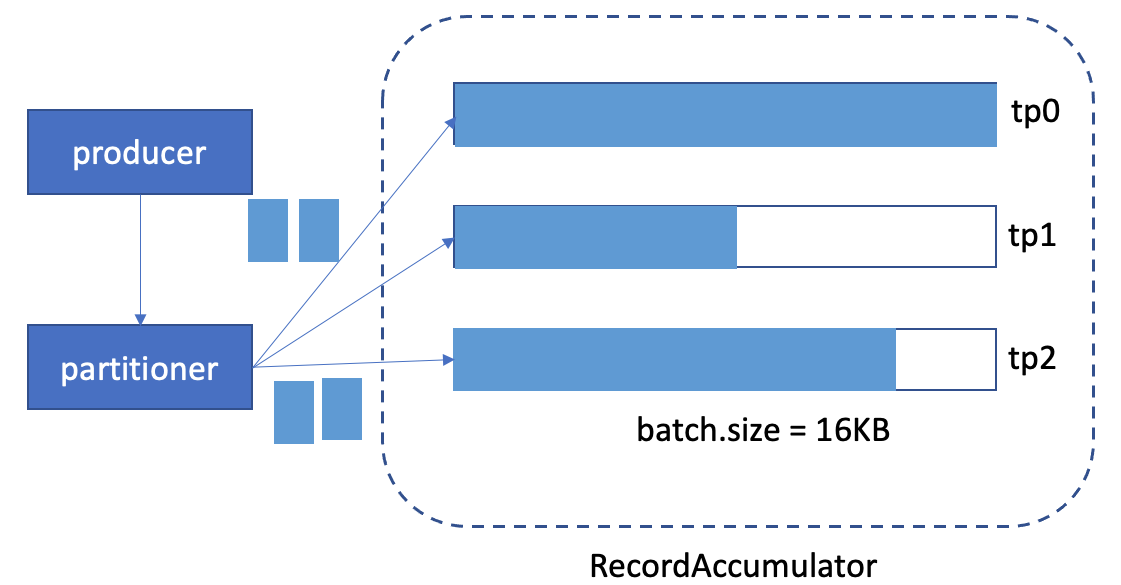| Table of Contents |
|---|
Status
Current state: "Under DiscussionVoting"
Discussion thread: here
JIRA: here
Please keep the discussion on the mailing list rather than commenting on the wiki (wiki discussions get unwieldy fast).
...
Records are sent until either of above 2 thresholds are reached.
The high level producer component diagram is like this:
...
2. peak time, the graph might look like this:
We can see, the tp0 batch is full, and need to create new batch for it and send out this batch soon.
...
Furthermore, currently batch.size is used in two conditions:
1. When we append records to a batch in the accumulator, we create a new batch if the current batch would exceed the batch.size.
2. When we drain the batch from the accumulator, a batch becomes 'ready' when it reaches batch.size.
The second condition is good with the current batch size, because if linger.ms is greater than 0, the send can be triggered by accomplishing the
batching goal.
The first condition, though, leads to creating many batches if the network latency or production rate (or both) is high, and with 5 in-flight and 16KB batches we can only have 80KB of data in-flight per partition. Which means that with 50ms latency, we can only push ~1.6MB/sec per partition (this goes down if we consider higher latencies, e.g. with 100ms we can only push ~0.8MB/sec).
...
In this KIP, I'm going to introduce a dynamic expandable buffer size for producer, with a larger allowable batch size (i.e. "batch.max.size").
Goal:
- higher throughput: with the "batch.max.size" introduced, the batch can allow ("batch.size" < records < "batch.max.size") to be sent within one batch. So, even a sudden high producer rate, the throughput can still be good.
- better memory usage: with "batch.initial.size" introduced, the initial memory allocation will be small. So when setting the "batch.size", you don't have to consider the memory waste issue anymore.
Public Interfaces
2 Producer config will be introduced:
- batch.initial.size: It specifies the initial batch size when new batch created (default is 0(disabled), which means we'll always allocate , it should be <= "batch.size" buffer and no buffer expansion will happen(default is 4096(4KB))
- batch.max.size: It specifies the maximum batch size in bytes per partition, it should be less than <= "max.request.size" and >= "batch.size". ("batch.max.size" default to 262144(256KB))
...
- "batch.size" = "batch.initial.size" * n (n means the times we expansion)
- "batch.max.size" = "batch.initial.size" * n m (n m means the times we expansion)
...
1. "batch.size" = 16KB, "batch.initial.size" = 2KB4KB
=> 16KB = 2KB * 84
2. "batch.size" = 16KB, "batch.initial.size" = 0 (default, disabled), 4KB, "batch.max.size" = 256KB
=> 256KB = 16KB 4KB * 1664
Proposed Changes
We'll allocate the "batch.initial.size" (default disabled, which will use "batch.size" as initial batch size4KB) memory when new records send to an empty partition buffer. While we accumulated more records in the partitions to reach the "batch.initial.size" (ex: 2KB4KB), we'll do buffer expansion to allocate another "batch.initial.size" of buffer and list with the previous buffer. And then, keeps accumulating the records.
When As current producer, when the batch reaching the "batch.size" of the buffer, it means the buffer is "ready" to be be sent. But now, before the sender thread is ready to send the batch, if there are more data coming, we can still accumulate it into the same buffer, until it reached the "batch.max.size" or sender thread send this batch out. After it reached the "batch.max.size", we'll create another batch for it. Compared with current producer, when reaching the "batch.size", we'll mark it as "ready" to be sent, and create a new batch for the upcoming records.
Internally, we have a BufferPool#free to keep the unused allocated buffers. When allocating a buffer, we'll first check if there are available buffer there before allocating a new one. With the expandable batch introduced, there are chances that sudden high producer rate, there are a lot of buffers being allocated, and then send back to BufferPool unused. Some of the buffers in BufferPool might not be used for a long time. In this KIP, when sending the allocated batches back to BufferPool#free after batch sent, we'll only keep maximum "batch.size" into pool, and mark the rest of memory as free to use. The reason we keep maximum "batch.size" back to pool is because the semantic of "batch.size" is the batch full limit. In most cases, the batch.size should be able to contain the records to be sent within linger.ms time.
So, let's see the 2 cases above
...
Compatibility, Deprecation, and Migration Plan
Because the "batch.initial.size" default value is 0(disabled), which means we'll always allocate "batch.size" buffer and no buffer expansion will happen, there will be always backward compatible. And the "batch.max.size" is transient to users2 new config for batch size introduced in this KIP. There will be always backward compatible. So no migration plan is needed.
Rejected Alternatives
- Do we really need batch.initial.size? It's not clear that having this extra setting adds a lot of value.
--> I made the default value to 4KB now, which means it'll make the producer's memory usage better after upgrading to the new release.N/A
